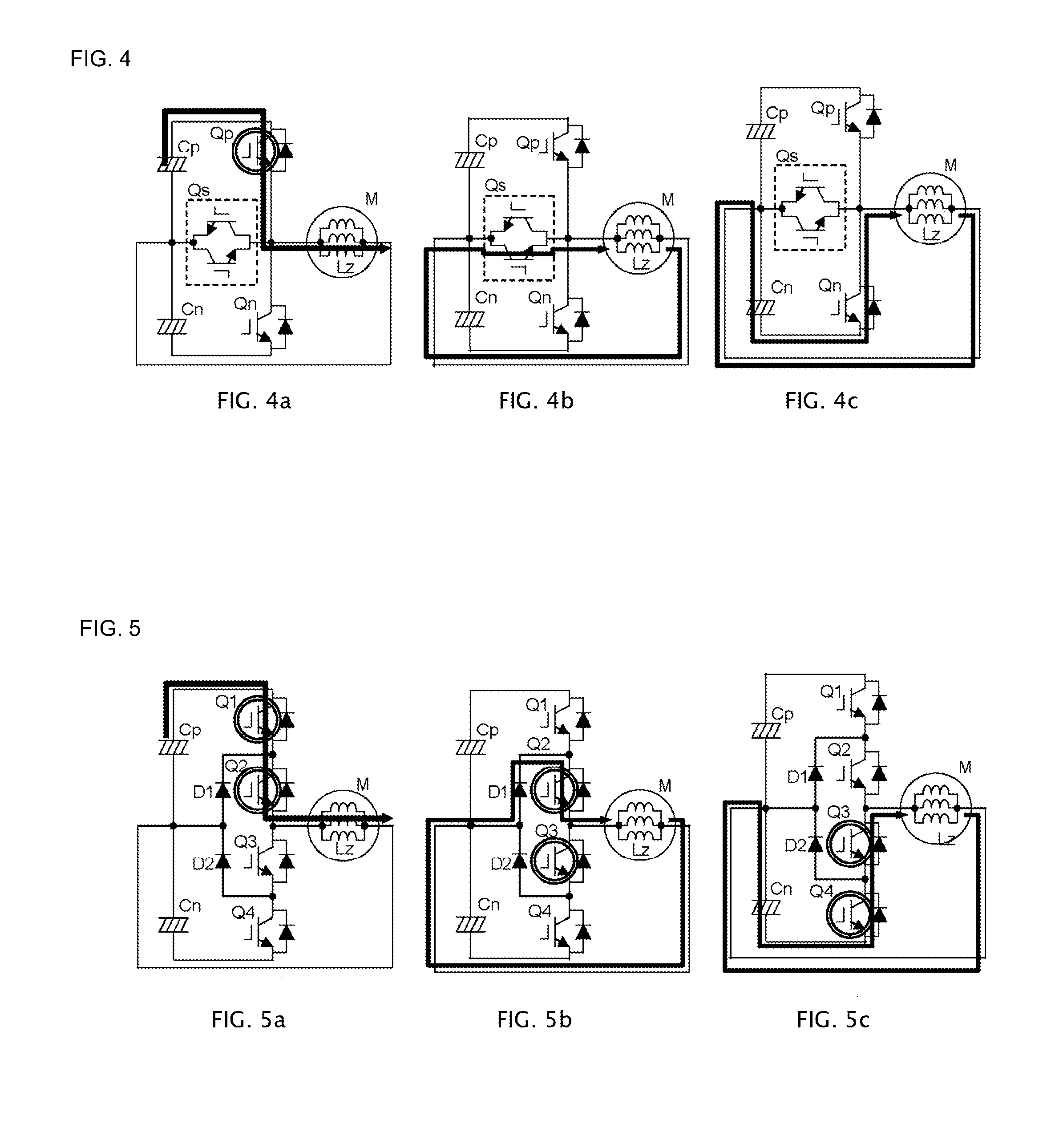Power conversion equipment
a technology of power conversion equipment and inverter, which is applied in the direction of power conversion systems, electrical apparatus, ac-dc conversion, etc., can solve the problems of increasing the cost of equipment, increasing the size of equipment, and increasing the power factor, so as to reduce the cost of equipment
- Summary
- Abstract
- Description
- Claims
- Application Information
AI Technical Summary
Benefits of technology
Problems solved by technology
Method used
Image
Examples
first embodiment
[0026]FIG. 1 shows a first embodiment of the invention. The embodiment is a power conversion equipment (a three-level inverter) that can output an alternating current voltage having three or more different potentials in a half-cycle period using IGBTs as semiconductor switching elements. A direct current circuit portion of the three-level inverter has a configuration wherein it has a series circuit of capacitors Cp and Cn between a positive electrode and a negative electrode as a direct current input, and a direct current power supply Ed is connected in parallel to the series circuit.
[0027]Also, an inverter INV has a configuration wherein each of bidirectional switches Qsu, Qsv, and Qsw, wherein reverse blocking type IGBTs are inverse parallel connected, is connected between alternating current terminals of a bridge circuit configured of six IGBTs (Qu, Qv, Qw, Qx, Qy, and Qz) and an internal connection point of the capacitor series circuit. Also, a connection point of the capacitor ...
second embodiment
[0035]FIGS. 5A to 5C show a second embodiment of the invention. FIGS. 5A to 5C show a circuit configuration in a common neutral point clamping type three-level inverter using a clamping diode. Hereafter, operations will be described.
[0036]FIG. 5A showing a mode wherein IGBTs Q1 and Q2 are turned on, and the alternating current load M is supplied from the positive side electrode capacitor Cp, energy is accumulated in the inductor Lz. Next, on the IGBT Q1 being turned off, and an IGBT Q3 turned on, the energy accumulated in the inductor Lz flows back via the IGBT Q2, as shown in FIG. 5B. Next, on the IGBT Q2 being turned off, and an IGBT Q4 turned on, the energy accumulated in the alternating current load is accumulated in the negative electrode side capacitor Cn via a diode inverse parallel connected to the IGBTs Q3 and Q4. Also, as a transfer of energy from the negative electrode side capacitor Cn to the positive electrode side capacitor Cp is also an inversely symmetrical operation...
third embodiment
[0038]FIG. 6 shows a third embodiment of the invention. It is an equivalent circuit focused on a zero phase sequence component showing an embodiment in a five-level inverter. A five-level inverter is a power conversion circuit that outputs an alternating current voltage having five potentials in a half-cycle period. A configuration is such that the two capacitors Cp and Cn of the direct current input of the inverter INV of the first embodiment shown in FIG. 1 are changed to four capacitors Cp1, Cp2, Cn1, and Cn2, and bidirectional switches are connected between connection points of the capacitors and alternating current outputs of the inverter. A neutral point of a load and an intermediate connection point of the series capacitor are connected.
[0039]Operations in this kind of configuration are similar to those in the first embodiment.
[0040]In a mode in which the IGBT Qp is turned on and off, on the IGBT Qp being turned on, the series circuit of the capacitors Cp1 and Cp2 is a power ...
PUM
 Login to View More
Login to View More Abstract
Description
Claims
Application Information
 Login to View More
Login to View More - R&D
- Intellectual Property
- Life Sciences
- Materials
- Tech Scout
- Unparalleled Data Quality
- Higher Quality Content
- 60% Fewer Hallucinations
Browse by: Latest US Patents, China's latest patents, Technical Efficacy Thesaurus, Application Domain, Technology Topic, Popular Technical Reports.
© 2025 PatSnap. All rights reserved.Legal|Privacy policy|Modern Slavery Act Transparency Statement|Sitemap|About US| Contact US: help@patsnap.com



